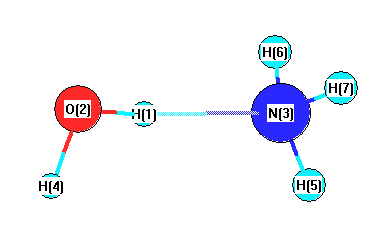Vibrational Frequencies calculated at HF/aug-cc-pVQZ
| Mode Number |
Symmetry |
Frequency
(cm-1) |
Scaled Frequency
(cm-1) |
IR Intensities
(km mol-1) |
Raman Act
(Å4/u) |
Dep P |
Dep U |
|---|
| 1 |
A' |
4202 |
3818 |
111.49 |
|
|
|
| 2 |
A' |
4019 |
3651 |
325.01 |
|
|
|
| 3 |
A' |
3809 |
3460 |
10.77 |
|
|
|
| 4 |
A' |
3686 |
3349 |
0.03 |
|
|
|
| 5 |
A' |
1789 |
1625 |
6.57 |
|
|
|
| 6 |
A' |
1777 |
1615 |
83.65 |
|
|
|
| 7 |
A' |
1156 |
1050 |
188.32 |
|
|
|
| 8 |
A' |
402 |
365 |
91.08 |
|
|
|
| 9 |
A' |
170 |
155 |
49.57 |
|
|
|
| 10 |
A' |
144 |
131 |
6.61 |
|
|
|
| 11 |
A" |
3807 |
3458 |
11.99 |
|
|
|
| 12 |
A" |
1787 |
1623 |
20.81 |
|
|
|
| 13 |
A" |
622 |
565 |
138.53 |
|
|
|
| 14 |
A" |
167 |
152 |
39.83 |
|
|
|
| 15 |
A" |
21 |
19 |
79.39 |
|
|
|
Unscaled Zero Point Vibrational Energy (zpe) 13778.5 cm
-1
Scaled (by 0.9085) Zero Point Vibrational Energy (zpe) 12517.8 cm
-1
See section
III.C.1 List or set vibrational scaling factors
to change the scale factors used here.
See section
III.C.2
Calculate a vibrational scaling factor for a given set of molecules
to determine the least squares best scaling factor.
Charges, Dipole, Quadrupole and Polarizability
Charges from optimized geometry at HF/aug-cc-pVQZ
Charges (e)
| Number |
Element |
Mulliken |
CHELPG |
AIM |
ESP |
| 1 |
H |
0.244 |
|
|
|
| 2 |
O |
-0.579 |
|
|
|
| 3 |
N |
-0.564 |
|
|
|
| 4 |
H |
0.287 |
|
|
|
| 5 |
H |
0.212 |
|
|
|
| 6 |
H |
0.200 |
|
|
|
| 7 |
H |
0.200 |
|
|
|
Electric dipole moments
Electric dipole components in Debye
(What's a Debye? See section
VII.A.3)
| |
x |
y |
z |
Total |
| |
1.265 |
-3.120 |
0.000 |
3.366 |
| CHELPG |
|
|
|
|
| AIM |
|
|
|
|
| ESP |
|
|
|
|
Electric Quadrupole moment
Quadrupole components in D Å
| Primitive |
|---|
| | x | y | z |
|---|
| x |
-11.752 |
3.493 |
0.000 |
| y |
3.493 |
-12.470 |
0.000 |
| z |
0.000 |
0.000 |
-13.629 |
|
| Traceless |
|---|
| | x | y | z |
|---|
| x |
1.297 |
3.493 |
0.000 |
| y |
3.493 |
0.221 |
0.000 |
| z |
0.000 |
0.000 |
-1.518 |
|
| Polar |
|---|
| 3z2-r2 | -3.036 |
|---|
| x2-y2 | 0.718 |
|---|
| xy | 3.493 |
|---|
| xz | 0.000 |
|---|
| yz | 0.000 |
|---|
|
Polarizabilities
Components of the polarizability tensor.
Units are
Å
3 (Angstrom cubed)
Change units.
| |
x |
y |
z |
| x |
2.955 |
0.100 |
0.000 |
| y |
0.100 |
3.503 |
0.000 |
| z |
0.000 |
0.000 |
2.859 |
<r2> (average value of r
2) Å
2
| <r2> |
61.894 |
| (<r2>)1/2 |
7.867 |
